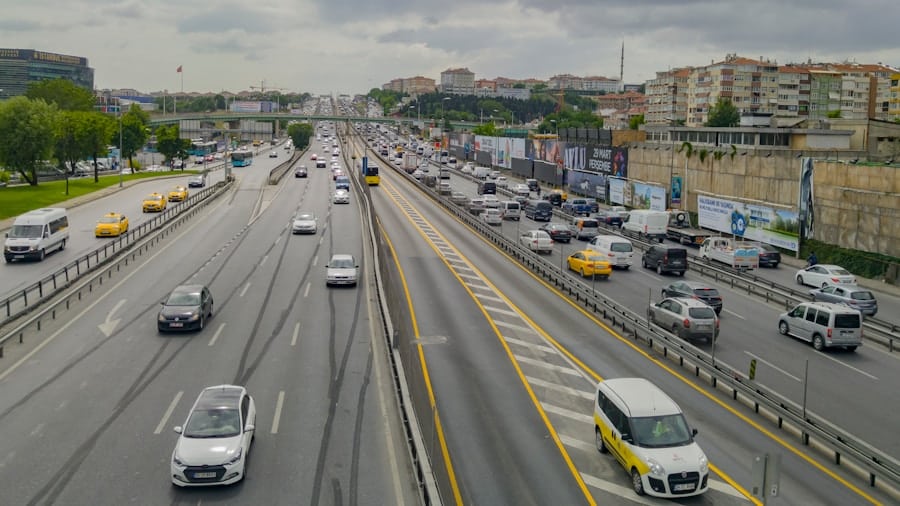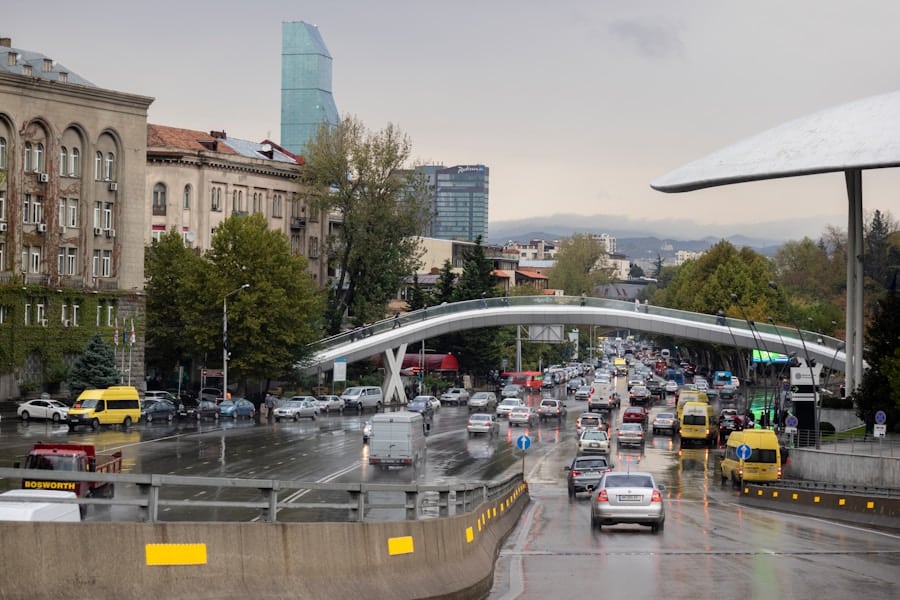Augmented Reality (AR) has emerged as a transformative technology in various sectors, and urban traffic management is no exception. By overlaying digital information onto the physical world, AR provides a unique lens through which traffic systems can be visualized and managed more effectively. This technology allows city planners, traffic engineers, and law enforcement agencies to gain real-time insights into traffic conditions, enabling them to make informed decisions that enhance the flow of vehicles and improve safety on the roads.
The integration of AR into urban traffic management systems represents a significant leap forward in how cities can address the complexities of modern transportation networks. The urban landscape is increasingly characterized by congestion, accidents, and inefficiencies that arise from outdated traffic management practices. Traditional methods often rely on static data and historical trends, which may not accurately reflect current conditions.
This capability not only aids in immediate decision-making but also supports long-term urban planning initiatives aimed at creating more sustainable and efficient transportation systems. As cities continue to grow and evolve, the adoption of AR in traffic management will likely become a critical component of smart city initiatives.
Key Takeaways
- AR technology can revolutionize urban traffic management by providing real-time data and enhancing decision-making processes.
- Using AR in monitoring traffic flow can lead to improved safety, reduced congestion, and more efficient use of infrastructure.
- Challenges in implementing AR in urban traffic management include high costs, technical limitations, and the need for extensive data integration.
- Case studies have shown successful AR implementation in traffic management, such as the use of AR glasses for traffic signal maintenance and AR-based navigation systems for drivers.
- The future of AR in traffic flow monitoring holds potential for advanced analytics, predictive modeling, and seamless integration with autonomous vehicles.
The Benefits of Using AR in Monitoring Traffic Flow
Enhanced Traffic Management
With AR applications, traffic managers can project real-time traffic data onto a physical map, enabling them to identify areas of congestion and respond promptly. This immediate access to information enables quicker responses to incidents, potentially reducing the duration of traffic disruptions and improving overall road safety.
Increased Public Engagement
AR technology can also enhance public engagement in traffic management. By utilizing AR applications, citizens can access real-time traffic information on their smartphones or AR glasses, allowing them to make informed decisions about their travel routes. This transparency fosters a sense of community involvement in urban planning processes.
Improved Urban Planning
For example, an AR app could allow users to visualize upcoming roadwork or detours in their vicinity, helping them plan alternative routes and avoid delays. Such engagement not only empowers citizens but also helps traffic authorities gather valuable feedback on public perceptions and behaviors related to traffic management.
The Challenges of Implementing AR in Urban Traffic Management

Despite its potential benefits, the implementation of AR in urban traffic management is fraught with challenges. One major hurdle is the need for substantial investment in infrastructure and technology. Cities must upgrade their existing traffic management systems to integrate AR capabilities, which may involve significant costs for hardware, software development, and training personnel.
Additionally, the integration of AR with existing systems requires careful planning to ensure compatibility and functionality across various platforms. Another challenge lies in data accuracy and reliability. For AR applications to be effective, they must rely on high-quality data sources that provide real-time updates on traffic conditions.
However, many urban areas struggle with outdated or incomplete data due to limitations in sensor networks or data collection methods. Ensuring that AR systems have access to accurate and timely information is crucial for their success. Furthermore, there are concerns about the potential for information overload; if users are bombarded with too much data or irrelevant notifications, it could lead to confusion rather than clarity.
Case Studies of Successful AR Implementation in Traffic Management
Several cities around the world have begun to explore the potential of AR in traffic management with promising results. One notable example is the city of Hamburg, Germany, which has implemented an AR-based navigation system for its public transportation network. This system overlays real-time information about bus and train schedules onto users’ views of the city through their smartphones.
Commuters can see when the next vehicle will arrive at their stop and receive alerts about delays or service changes. This application not only improves user experience but also encourages greater use of public transport by making it more accessible and user-friendly. In another instance, the city of Seoul, South Korea, has developed an AR application that assists drivers in navigating complex intersections.
The app provides visual cues that highlight optimal routes and warn drivers about potential hazards or heavy traffic areas. By enhancing situational awareness for drivers, this technology has contributed to a reduction in accidents at notoriously dangerous intersections. These case studies illustrate how AR can be effectively integrated into existing traffic management frameworks to improve safety and efficiency.
The Future of AR in Traffic Flow Monitoring
Looking ahead, the future of AR in traffic flow monitoring appears promising as advancements in technology continue to evolve. The integration of artificial intelligence (AI) with AR could lead to even more sophisticated traffic management solutions. AI algorithms can analyze vast amounts of data from various sources—such as sensors, cameras, and social media—to predict traffic patterns and suggest optimal routes for drivers in real time.
When combined with AR visualizations, this could create a powerful tool for managing urban mobility. Moreover, as 5G technology becomes more widespread, the capabilities of AR applications will expand significantly. The high-speed connectivity offered by 5G will enable real-time data transmission with minimal latency, allowing for more accurate and timely updates on traffic conditions.
This will enhance the effectiveness of AR applications by providing users with instantaneous information about their surroundings. As cities continue to embrace smart technologies, the role of AR in traffic management will likely become increasingly central to efforts aimed at creating more efficient and sustainable urban environments.
The Role of AR in Managing Traffic Congestion

Traffic congestion remains one of the most pressing challenges faced by urban areas worldwide. AR has the potential to play a pivotal role in alleviating congestion by providing drivers with real-time information that helps them make better travel decisions.
By distributing traffic more evenly across the road network, such systems can help reduce bottlenecks and improve overall flow. Additionally, AR can assist city planners in identifying congestion hotspots through data visualization techniques. By overlaying historical traffic data onto maps of urban areas, planners can pinpoint locations where congestion frequently occurs and develop targeted interventions to address these issues.
For example, if an intersection consistently experiences heavy delays during peak hours, planners can use this information to redesign the intersection or implement signal timing adjustments that facilitate smoother traffic flow. The proactive use of AR in this manner can lead to long-term improvements in urban mobility.
The Integration of AR with Other Technologies in Traffic Management
The integration of AR with other emerging technologies is essential for maximizing its impact on urban traffic management. For instance, combining AR with Internet of Things (IoT) devices can create a comprehensive ecosystem for monitoring and managing traffic conditions. IoT sensors placed throughout a city can collect data on vehicle counts, speeds, and environmental conditions.
This data can then be fed into an AR platform that visualizes real-time conditions for traffic managers and commuters alike. Furthermore, integrating AR with vehicle-to-everything (V2X) communication systems can enhance safety and efficiency on the roads. V2X technology allows vehicles to communicate with each other and with infrastructure elements such as traffic lights and road signs.
When combined with AR applications, this communication can provide drivers with critical information about upcoming hazards or changes in traffic signals directly within their field of vision. Such integration not only improves situational awareness but also fosters a more connected transportation ecosystem that prioritizes safety and efficiency.
Ethical and Privacy Considerations in Using AR for Traffic Monitoring
As with any technology that collects and analyzes data from individuals, ethical and privacy considerations are paramount when implementing AR for traffic monitoring. The collection of real-time data from vehicles and pedestrians raises concerns about surveillance and individual privacy rights. It is essential for city planners and technology developers to establish clear guidelines regarding data usage and ensure that personal information is anonymized to protect citizens’ privacy.
Moreover, transparency is crucial in building public trust around the use of AR technologies in traffic management. Citizens should be informed about what data is being collected, how it will be used, and who has access to it. Engaging the public in discussions about these issues can help alleviate concerns and foster a collaborative approach to urban planning that respects individual rights while leveraging technology for the greater good.
As cities continue to explore the potential of AR in traffic management, addressing these ethical considerations will be vital for ensuring responsible implementation that benefits all stakeholders involved.
In a related article, “Unlock Your Creative Potential with the Samsung Galaxy Book Flex2 Alpha,” the capabilities of the Samsung Galaxy Book Flex2 Alpha are explored in depth. This article discusses how this device can enhance productivity and creativity for users in various fields. The integration of advanced technology in devices like the Samsung Galaxy Book Flex2 Alpha showcases the potential for innovation in urban traffic management systems, such as the use of AR to monitor and manage traffic flow efficiently. To read more about this innovative device, visit here.
FAQs
What is AR?
AR stands for Augmented Reality, which is a technology that superimposes digital information such as images, videos, or 3D models onto the real world environment.
How does AR help in monitoring and managing urban traffic flow?
AR can be used to overlay real-time traffic data, such as congestion, accidents, or road closures, onto a driver’s field of view. This allows for better decision-making and navigation, ultimately improving traffic flow.
What are the benefits of using AR in urban traffic management?
Some benefits of using AR in urban traffic management include improved situational awareness for drivers, reduced congestion, enhanced safety, and more efficient use of road infrastructure.
What are some examples of AR applications in urban traffic management?
Examples of AR applications in urban traffic management include heads-up displays in vehicles that provide real-time traffic information, AR-enabled navigation apps, and smart traffic lights that use AR to optimize traffic flow.
Are there any challenges in implementing AR for urban traffic management?
Challenges in implementing AR for urban traffic management include the cost of AR technology, privacy concerns related to data collection, and the need for infrastructure upgrades to support AR-enabled traffic management systems.

